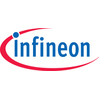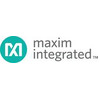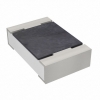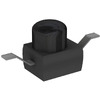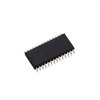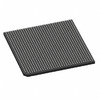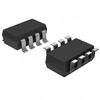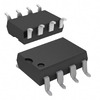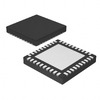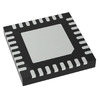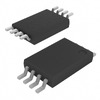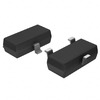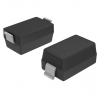Exploring the Features and Performance of the W5500 Hardwired TCP/IP Controller
The W5500 chip stands as a carefully engineered TCP/IP Ethernet controller, designed to ease Internet integration in embedded systems. By offloading complex networking operations from the microcontroller, it facilitates smooth and efficient Internet interaction, allowing devices to connect without hindrance. This discussion delves into the versatile functions and extensive uses of the W5500 Hardwired TCP/IP Embedded Ethernet Controller. The objective is to nurture a deep comprehension and to harness its capabilities venturing into the intricate world of embedded design, bringing forth the desire to understand and innovate.Catalog

Overview of the W5500
The W5500, cherished for its capability to integrate Internet accessibility into myriad devices and applications, serves a unique role as an Ethernet controller. Its embedded hardwired TCP/IP stack, combined with 10/100 Ethernet MAC and PHY capabilities, lessens the usual intricacies of networking functions. This singular component accommodates an array of protocols like TCP, UDP, IPv4, ICMP, ARP, IGMP, and PPPoE, offering diverse options for projects that need dependable internet connectivity. The essence of W5500’s operations lies in its 32Kbyte internal buffer, in achieving smooth and trustworthy data exchange. This expansive buffer facilitates seamless data flow, which is use in settings demanding both stability and rapidity. Employing devices featuring the W5500 is known to potentially diminish packet loss and amplify throughput. This trait is astoundingly advantageous for applications requiring data exchanges.
The W5500 finds its practical niche in sectors ranging from home automation to industrial IoT implementations. Its prowess in maintaining uninterrupted data flow manifests in scenarios craving constant connectivity. For instance, in home automation, the chip streamlines device communications, ensuring continuous operation. Viewing enterprise adoption of these elements reveals the tangible success and efficiency this controller delivers. Incorporating the W5500 into project designs not only streamlines the development trajectory but also enhances the expandable nature of the final product. By reducing the dependency on surplus networking components, you are free to concentrate on creativity and practical features instead of technical complications. Such thoughtful inclusion of straightforward yet robust technology frequently accelerates project completion and curtails expenditures.
The evolving nature and uptake of devices like the W5500 highlight an extensive movement towards simpler and more efficient networking answers in today's tech landscape. With rising connectivity demands, solutions offering sturdy, extensible networking choices are increasingly forming the backbone of contemporary digital endeavors. This evolution vividly illustrates the influence of such innovations in paving the path forward in the connected devices.
W5500 Pin Configuration

W5500 Symbol, Footprint, and CAD Model



Block Diagram of W5500

W5500 Technical Specifications
|
Type |
Parameter |
|
Factory Lead Time |
8 Weeks |
|
Surface Mount |
YES |
|
Operating Temperature |
-40°C-85°C |
|
Published |
2013 |
|
Moisture Sensitivity Level (MSL) |
3 (168 Hours) |
|
Voltage - Supply |
2.97V-3.63V |
|
Terminal Form |
GULL WING |
|
Supply Voltage |
3.3V |
|
Time@Peak Reflow Temperature-Max (s) |
NOT SPECIFIED |
|
Number of Channels |
8 |
|
Operating Supply Current |
132mA |
|
uPs/uCs/Peripheral ICs Type |
MICROPROCESSOR CIRCUIT |
|
Number of Transceivers |
1 |
|
Length |
7mm |
|
RoHS Status |
ROHS3 Compliant |
|
Package / Case |
48-LQFP |
|
Number of Pins |
48 |
|
Packaging |
Strip |
|
Part Status |
Active |
|
Number of Terminations |
48 |
|
Terminal Position |
QUAD |
|
Peak Reflow Temperature (Cel) |
NOT SPECIFIED |
|
Terminal Pitch |
0.5mm |
|
Function |
Controller |
|
Interface |
SPI |
|
Max Supply Current |
132mA |
|
Protocol |
Ethernet |
|
Standards |
10/100 Base-T/TX PHY |
|
Width |
7mm |
|
Lead Free |
Lead Free |
Features of the W5500
W5500 Distinctive Attributes and Functionalities
The W5500 stands out with an array of sophisticated features designed to enhance Ethernet application performance. A notable characteristic is its absence of IP fragmentation support, which demands attentive management of packets. This often results in more streamlined network traffic and reduced overhead, potentially boosting the performance of specific applications in a subtle yet effective manner.
Energy Efficiency and Network Coordination
The chip includes a power-down mode that curtails energy usage during idle periods, making it beneficial for IoT devices and remote systems where judicious power management is valued. Additionally, the Wake on LAN over UDP feature showcases the balance between minimal energy usage and constant connectivity. This facilitates transitions into low-power states with the capability to awaken when network activity necessitates, maintaining readiness without constant energy drain.
Enhanced Throughput with Multi-Socket Capability
With support for up to 8 concurrent sockets, the W5500 offers substantial improvements in multitasking abilities over the network. This is advantageous for applications needing simultaneous data stream management, providing adaptability to accommodate diverse network needs while preserving both speed and reliability. In applications, managing diverse communication streams without interruption is central to achieving an effective network system.
High-Speed SPI Interface and Memory Allocation
The W5500 supports high-speed SPI communication for data-intensive tasks requiring rapid transmission to avoid congestion. The inclusion of a 32K bytes memory buffer reinforces this capability by offering ample space for data processing, which aids in sustaining throughput and stable performance. This synergy between speed and ample buffering exemplifies the need to optimize systems for dynamic data volumes.
Flexible Ethernet Mode Options
The W5500 is adaptable, supporting both full and half duplex Ethernet operations to accommodate different network designs and needs. Full duplex addresses the needs of environments requiring simultaneous two-way communication without collision, while half duplex is efficient for more straightforward configurations. This adaptability highlights the role of flexible network components in varying application settings where requirements may not always be predictable.
Environmental Considerations and Export of W5500
RoHS Status
The W5500 aligns with RoHS guidelines, which focus on constructing devices in an environmentally responsible manner by restricting certain hazardous materials. This alignment plays a role both in sustaining the environment and complying with diverse legal stipulations in global markets. A nuanced comprehension of RoHS standards enhances the appreciation of these environmentally-conscious initiatives.
Moisture Sensitivity Level (MSL)
Possessing a moisture sensitivity level of 3, the W5500 prospers across a variety of storage and operational settings. This rating signifies the necessity for careful handling to avert moisture-related damage, an essential factor during production and assembly phases. The integration of moisture-sensitivity protocols, perfected over extensive manufacturing cycles, consistently supports the long-term reliability of such delicate components.
ECCN and HTSUS
The classification of this chip according to ECCN and HTSUS codes contributes to smoothing international trade processes. These codes enable accurate product identification for export adherence and tariff assessments. Navigating trade compliance necessitates meticulous information handling and expert management, in a global economy where regulations differ widely. Utilizing these codes streamlines regulatory navigation, easing the complexity of international trade.
Applications of the W5500
Industrial Automation
In industrial automation, the W5500's adaptability allows it to seamlessly integrate into various network protocols, strengthening industrial IoT (IIoT) connectivity. By facilitating interactions among sensors, actuators, and central controllers, it enhances the flexibility and swift adaptiveness of automated production lines. There is a notable improvement in maintaining high standards in process controls and quality assurance. Its application in predictive maintenance techniques contributes to reducing downtime and extending the lifespan of machinery.
Healthcare Technology
In healthcare technology, the W5500 enriches device interoperability. Reliable network connections facilitate the accurate transfer of data from patient monitoring systems to centralized health information systems, thus improving clinical decision-making's timing and efficacy. This integration drives towards more intelligent healthcare solutions, optimizing operations and bolstering patient outcomes.
Server Infrastructure
Integrating the W5500 into server settings enhances the operational efficacy and stability of data centers, where robust networking is required. Its ability to manage multiple connections simultaneously supports the scalability needed for cloud services and virtual environments, maintaining uniform service delivery. Industry veterans recommend its usage to uphold robust network performance and cater to growing data traffic demands seamlessly.
Network Devices
The W5500's versatility extends to a variety of network devices such as set-top boxes and network printers by improving connectivity. In set-top boxes, it allows for smoother streaming and seamless content provision, while in network printers, it ensures reliable document management and processing. Implementations often demonstrate a nuanced grasp of network demands, translating into satisfaction and operational efficiency.
Interface Conversion
Ultimately, the W5500 is proficient in converting interfaces like serial, parallel, USB, and GPIO applications, boosting device connectivity across varied systems. By bridging communication between different technologies, it ensures smooth integration and functionality. Many utilizing these devices benefit from an expansion of design possibilities and enhanced system cohesion, nurturing innovation in ecosystems involving multiple devices.
Comparison Between W5500 and W5100
As technology evolves, there is always a yearning for better hardware in network communications. In the Ethernet-based networks, the W5500 and W5100 chips play a roles, each bringing distinct characteristics that sway their choice in various scenarios. The W5500 chip garners appreciation for its remarkable data handling and budget-friendly nature when juxtaposed with the W5100. Its capability to efficiently manage increased data throughput and multiple socket connections wins favor among engineers. This is especially beneficial in web server contexts, where optimizing resources adds immense value.
Handling a greater number of sockets makes the W5500 a go-to for numerous networking applications. In environments where robust and scalable connections are a necessity, the W5500 shines. Consider server applications demanding steady and dependable connectivity; the W5500 aptly fulfills these requirements by its thoughtful design. The W5500 excels, yet the way it tackles RST packets merits attention. Certain situations might call for the adept RST management that the W5100 provides. Acknowledging these preferences is good to adeptly managing network interruptions or intricate communication protocols.
The W5500 offers a high-efficiency, budget-conscious option suitable for most web server settings, yet certain scenarios require the precise packet handling of the W5100. Weighing these chips' attributes alongside practical crafts informed strategies for network deployment.
Alternatives of W5500
|
Part
Number |
Manufacturer |
Package / Case |
Number of Pins |
Interface |
Supply Voltage |
Terminal Pitch |
Lead Free |
Number of Terminations |
Terminal Position |
|
TMS320F28021PTT |
Texas Instruments |
48-LQFP |
48 |
I2C, SPI, UART, USART |
3.3 V |
0.5 mm |
Lead Free |
48 |
QUAD |
|
STM32F030C8T6 |
STMicroelectronics |
48-LQFP |
48 |
I2C, SCI, SPI, UART, USART |
1.8 V |
0.5 mm |
Lead Free |
48 |
QUAD |
|
TMS320F28027PTT |
Texas Instruments |
48-LQFP |
48 |
I2C, SCI, SPI, UART, USART |
3.3 V |
0.5 mm |
Lead Free |
48 |
QUAD |
|
TMS320F280200PTT |
Texas Instruments |
48-LQFP |
48 |
I2C, SCI, SPI, UART, USART |
1.8 V |
0.5 mm |
Lead Free |
48 |
QUAD |
Dimensions of W5500

W5500 Manufacturer Information
Founded in South Korea, WIZnet has carved out a distinct identity within the specialized arena of TCP/IP Offload Engine technology. They are adept at designing solutions that facilitate seamless internet connectivity for embedded systems, demonstrating a high level of expertise in this field. The iMCU™ series prominently features the W5500, a notable innovation that reflects WIZnet's ongoing efforts to advance embedded Internet capabilities. This product underlines their enthusiasm for improving network performance and meeting the evolving needs of modern technologies. In considering their overall impact, it becomes apparent how WIZnet's contributions propel both specific initiatives and broader technological developments. Many industry find substantial value in their robust solutions for overcoming connectivity barriers, highlighting the brand’s influential presence in the realm of technology.
Datasheet PDF
TMS320F28021PTT Datasheets:
STM32F030C8T6 Datasheets:
STM32F030x4,6,8,C Datasheet.pdf
TMS320F28027PTT Datasheets:
TMS320F28027PTT Datasheets:
About us
ALLELCO LIMITED
Read more
Quick inquiry
Please send an inquiry, we will respond immediately.
Frequently Asked Questions [FAQ]
1. What is the operational voltage range for the W5500?
The W5500 operates within a voltage range of 2.97V to 3.63V, aligning with varied power supply conditions in embedded systems. This adaptability illustrates its usefulness in settings where power consistency can be a concern, reflecting a design that appreciates stability.
2. What is the specified temperature range for the W5500?
Designed to function effectively between -40°C and 85°C, the W5500 proves itself in diverse climates and industrial settings. Its ability to maintain functionality under extreme temperatures highlights a thoughtfully engineered resilience for application challenges.
3. How does W5500 compare with W5100 in terms of functionality?
The W5500 distinguishes itself from the W5100 through improved cost-efficiency and enhanced performance. With support for up to eight sockets, it is suitable for network-intensive tasks like web servers, showcasing an evolution to meet increasing demands for bandwidth and data processing efficiency.
4. What are the applications of the W5500?
In embedded systems, the W5500 facilitates Internet connectivity with ease. It integrates network capabilities into a wide spectrum of devices, ranging from simple sensors to complex industrial controllers. This range of applications underscores its role in connecting digital devices to a global network, propelling advancements in the Internet of Things (IoT).
5. How does the structure of the W5500 enable its operations?
Integrating the TCP/IP stack, Ethernet MAC, and PHY into a single chip, the W5500 offers a comprehensive Internet functionality in a compact form. This integration streamlines design processes and reduces the need for extra components. By consolidating functionalities, it enhances design efficiency and accelerates product development, embodying a response to industry demands for simplicity without compromising on capability.

Exploring the LF356 Op-Amp: Pinout and Package Specifications
on November 4th

TCMT4100 Transistor Output Optocouplers: Specifications, Alternatives, and Datasheet
on November 4th
Popular Posts
-

Understanding Power Supply Voltages in Electronics VCC, VDD, VEE, VSS, and GND
on June 13th 24175
-

USB-C Pinout and Features
on June 13th 21286
-

The Ultimate Guide to Wire Color Codes in Modern Electrical Systems
on January 1th 17465
-

TL494 Current-Mode PWM Controller IC
on January 1th 14733
-

Current Divider Circuits and Effective Use of the Divider Formula
on January 1th 13630
-

FET (Field Effect Transistor) Circuit Symbols
Field-Effect Transistors (FETs) are widely used in modern electronics and are found in everything from simple devices to complex digital systems. To work with these transistors effectively, it's helpful to understand the symbols that represent different types of FETs. These symbols do more than just show what the transistors look like—they also provide information about how each transistor works ...on January 1th 13440
-

Quality (Q) Factor: Equations and Applications
The quality factor, or 'Q', is important when checking how well inductors and resonators work in electronic systems that use radio frequencies (RF). 'Q' measures how well a circuit minimizes energy loss and impacts the range of frequencies the system can handle around its main frequency. In systems with inductors, capacitors, and tuned circuits, a higher 'Q' means the circuit focuses more on a spe...on January 1th 13393
-

Understanding and Building Op-Amp Based Peak Detectors
In the world of electronic circuit design, peak detectors are key tools for accurately analyzing and processing signal strengths. These circuits are designed to find and keep the highest signal amplitude, making sure the peak value is precisely captured and held as needed. Peak detectors are important in many fields, from improving audio quality in communication systems to aiding medical diagnoses...on June 13th 12497
-

LM741 Op-Amp: Features, Specifications, and Applications
The LM741 op-amp is a popular and flexible electronic component. This article goes over the pin layout, functions, specs, and different ways the LM741 can be used, while also comparing it to similar models like the LM358.Catalog1. What Is the LM741 Op-Amp?2. The LM741 Pin Configuration3. The LM741 Pin Functions4. Specifications of the LM7415. Features of LM7416. LM741 Circuit Applications7. LM741 ...on June 13th 12034
-

ST-LINK/V2: Pinout, Specifications, and Datasheet
This article takes you through the ST-LINK/V2, a well-regarded tool that amplifies connectivity and functionality. Key topics will cover its pinout configuration, delve into its 3D model, and spotlight specifications. Such understanding expands the horizons of STM microcontrollers in diverse applications. By grasping these interfaces and tools, you can transform embedded systems, opening doors to ...on January 1th 11579



